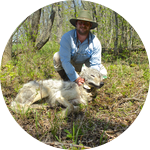Project Results
Through the kind financial support of 60 individuals/organizations, we were able to provide a more detailed understanding of wolf-beaver interactions as well as additional information about wolf foraging behavior. Regarding wolf-beaver interactions, we learned through our research that wolves hunt and kill beavers primarily by ambushing beavers. Interestingly, we found that even though wolves can kill substantial portions of the beaver population, it seems this high level of predation has little effect on beaver populations when the beaver population in an area is high.
Weekly summer diet of gray wolves (Canis lupus) in northeastern Minnesota
Gable, T.D., S.K. Windels, J.G. Bruggink, and S.M. Barber-Meyer
Journal Article
Kill rates and predation rates of wolves on beavers
Gable, T.D., S.K. Windels, and J.G. Bruggink
Journal Article
About This Project
Beavers can be the primary prey of wolves in boreal ecosystems. However, little research has been done to understand how wolves prey on beavers and the effect of wolf predation on beaver populations. My goal is to examine wolf predation of beavers and gain a greater understanding of this important predator-prey dynamic.
Ask the Scientists
Join The DiscussionWhat is the context of this research?
Beavers have several natural predators but the relationships between beavers and their predators are poorly understood. Beavers that inhabit northern climates are vulnerable to predation from spring to fall when ice cover is absent. Consequently, wolf predation of beavers is highest during this period. Wolves - which typically prey on hooved animals (deer, elk, moose, etc) - are opportunistic hunters and use alternative prey species, such as beavers, seasonally when they are abundant, vulnerable and easy to capture. As a result, beavers can be the primary prey of wolves during the summer in boreal ecosystems.
What is the significance of this project?
Our results will provide a more thorough understanding of the impact of wolf predation on beaver populations. Little is known about this predator-prey relationship even though beavers can be the primary prey of wolves from spring to fall in boreal ecosystems. Beavers are key drivers of ecosystem processes in boreal systems like Voyageurs National Park and understanding factors that can affect or limit their populations has implications for predator-prey dynamics, nutrient cycling, forest succession, and landscape-level patterns in wetland abundance and composition.
What are the goals of the project?
Our goal is to develop a greater understanding of the wolf-beaver dynamic that is present in many boreal ecosystems by examining wolf predation of beavers and the effect of wolf predation on beaver populations.
Specifically our objectives are to to examine:
1. the association between the proportion of wolf diet (biomass) comprised of beaver and beaver density
2. whether wolf predation of beavers is the result of wolves actively searching for beavers or encountering them incidentally
3. the impact of wolf predation on beaver population levels
Budget
WE HAVE REACHED OUR GOAL!! ANY EXTRA DONATIONS WILL HELP WITH PROJECT COSTS SUCH AS BUYING ANOTHER GPS COLLAR! THANKS EVERYONE!!!
Voyageurs National Park has kindly provided many of the supplies necessary for fitting wolves with GPS collars. However, many of the actual costs needed to run a wolf research project still exist and we have yet to get funding for those expenses.
Your help in funding these remaining expenses will be integral in making this project a success.
It should be noted that this is the minimum amount necessary to fund the project. Any money beyond our current goal would be used to purchase additional GPS wolf collars.
Meet the Team
Team Bio
My fascination with wolves started sometime ago. Since I was an undergraduate student I dreamed of studying these elusive predators. I have had the pleasure to work on a few wolf research projects since then in Grand Teton National Park, the Boundary Waters Canoe Area Wilderness and Voyageurs National Park as well as learn about their social behavior at Wolf Park, Indiana as a intern.
To my excitement I get to study wolves for my graduate project and explore some unknowns in wolf ecology!
Outside of wolves, I am generally passionate about all things wild. I enjoy being outside whether that is birding, hiking, canoeing or fly-fishing.
I love reading and some of my favorites are Sigurd Olson ("The Singing Wilderness" is one of my all time favorites), John Burroughs, Thoreau and Annie Dillard's "Pilgrim at Tinker Creek". I must also note that I am a huge John Denver and Gordon Lightfoot fan.
Additional Information

An aerial view of Voyageurs National Park. The park has a robust wolf and beaver population making it an ideal place to study this predator-prey dynamic.
 After ear tagging and radio collaring this wolf in 2014, this wolf rejoined his pack and provided valuable information about this pack in Voyageurs National Park.
After ear tagging and radio collaring this wolf in 2014, this wolf rejoined his pack and provided valuable information about this pack in Voyageurs National Park.
 Wolves are significant predators of beavers.
Wolves are significant predators of beavers.
 Beavers are important drivers of ecosystem processes and understanding how predators impact them is important.
Beavers are important drivers of ecosystem processes and understanding how predators impact them is important.

Beavers have had a dramatic impact on the landscape. This photograph shows how drastically beavers have changed the landscape in Voyageurs National Park.


A wolf collared in Voyageurs National Park in summer 2014. Much of the fieldwork for this project will consist of collaring wolves to understand how they use active beaver habitats.

Voyageurs National Park is a wild place of immense beauty.

Project Backers
- 60Backers
- 106%Funded
- $6,925Total Donations
- $115.42Average Donation
